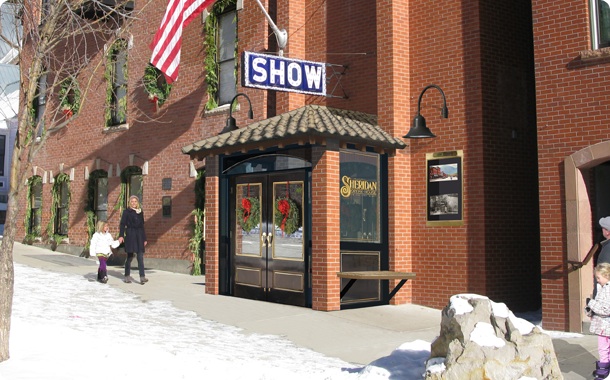
27 Jun Sheridan Opera House 100th: Speakeasy Gala
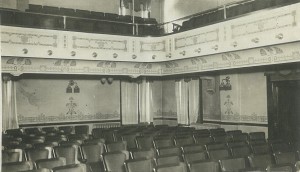
Sheridan Opera House, way back when. (From Segerberg family archives.)
Setting the scene:
Following a major facelift, on February 1, 1913, New York City’s Grand Central Terminal reopened as the world’s largest railroad station. Nice venue, but geographically undesirable.
In 1913, Houdini began performing his upside-down trick in which the magician had himself straightjacketed and suspended by his ankles from a tall building or crane. He would make his escape in full view of the assembled crowd. Nice party treat, but Houdini since made his ultimate escape and is no longer available for bookings.
On July 3 1913, the Telluride, the Sheridan Opera House, the town’s “jewel box” at 110 N. Oak Street, opened for business as the Segerberg Opera House.
Two years ago, when executive director Ronnie Palamar began planning the centennial celebration, she discovered the year 1913 gave her little to hang her hat on. It would be hard to build a party around the passage of the 16th amendment (the one that gave Congress the power to levy an income tax).
Fast forward seven short years, however, and the options change radically.
Enter the 1920s, when materialism and instant gratification trumped structure and spirituality. The wealthy (epitomized by the characters in “The Great Gatsby”) threw enormous and lavish parties and the rich got to appear richer by wearing fancy, expensive clothes and jewels. The rise of jazz, the all-American musical genre, in that era was part of the new post-war optimism: America was finally breaking away from European culture and coming into its own. F. Scott Fitzgerald labeled the 1920s “The Jazz Age.” Palamar called it one great excuse to party down.
The Speakeasy Gala:
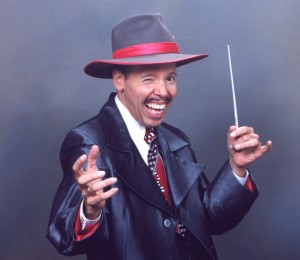
C. Calloway Brooks
Hi-de-hi-de-ho.
On Saturday, July 6, the historic Sheridan Opera House hosts its centennial celebration. The Speakeasy Gala is a black-tie affair featuring Prohibition-era drinks, music and dancing, a silent auction, and gambling. The party is the launch of a year-long fundraising campaign to restore the building’s entryway and replace its seats.
The event’s Legacy Auction features 10 items to commemorate each decade the Opera House has been in business, including an original 1920s movie poster, a set of pearls from the 1930s, the first Telluride Film Festival poster (with 2013 passes) from the 1970s, a 1980s Vespa, and original SOH seats.
Cabell Calloway III was born December 25, 1907. By age 18, he was working as a drummer. By his 20th birthday, he had organized his own orchestra and was singing lead vocals. In 1929, Cab Calloway was invited to fill in for Duke Ellington at New York’s Cotton Club. For the next decade, the two great bandleaders alternated engagements at the infamous venue.
It was during his Cotton Club Years that Calloway developed his crisp, jazzy song-and-dance style. Calloway was also one of the first performers to purposely use scat singing, or random use of nonsense syllables. As was the tradition, he began to scat when he forgot the lyrics of a song. Audiences, however, loved the sound, so Calloway began to write tunes with scat choruses. Calloway’s trademark song, “Minnie the Moocher,” is one example. Other hits include “Stormy Weather,” “It Ain’t Necessarily So” and “Geechie Joe.”
Calloway enjoyed a popular recording and touring career his whole life before he passed away in 1994. Nowadays, however, Calloway’s legend boogies on through his grandson, C. Calloway Brooks, whose orchestra is the featured entertainment for the gala night. Calloway’s band uses vintage orchestrations as a point of departure to create an authentic brand of Cotton Club-style music and hijinks.
Some like it hot. Don’t you?
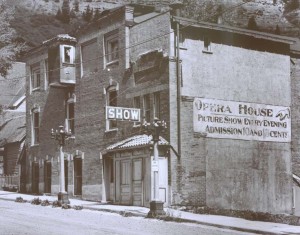
Sheridan Opera House, 1960s or 1970s
Upstairs, the Sheridan Opera House will be elegantly decorated to emulate the early days. Downstairs, the set-up is a secret speakeasy bar with casino tables, where the action starts when Calloway Brooks lowers his baton for the night.
Flapper and gangster costumes are highly encouraged for the evening of fun and games. Locally, Pip’s Fine and Funky Consignment, 100 West Colorado, always has tuxedos to rent, flapper dresses and fabulous faux bijoux for sale. (Tel: 970-728-3663.) And all-day Friday, July 5, in the the Gallery Room of the Sheridan Opera House, Durango’s Costume Emporium will have full sets of guy and gal threads for rent (or call 970-247-1857 to reserve yours early).
Tickets for the Speakeasy Gala are $75 general admission or $125 for limited first-class balcony access. General admission tickets come with two specialty drink coupons, fine chocolates from Telluride Truffle, and more. The balcony features those perks, appetizers, and a special bar for First Class patrons only, including absinthe, the anise-flavored spirit derived from botanicals, including the leaves of Artemisia absinthium. a.k.a. “grand wormwood” and known as “the green fairy.” (Cameo Hoyle of the Telluride Historical Museum will prepare the drink just as it was made in the bad old days.)
The history of the Sheridan Opera House and ongoing restoration:
The Sheridan Opera House was built by J.A. Segerberg and the Telluride miners in 1913 as a combination vaudeville and moving picture theatre (from 1914), with connecting floors to the lavish Victorian gem, the New Sheridan Hotel. The day the place opened, the newspaper of record, the Telluride Daily Journal, described the venue as one of the prettiest and best appointed “show houses” in the state.
The last historical commercial structure built in the town until Telluride saw a reawakening as a ski area in the early 1970s, the venue attracted variety shows, orchestras, and touring theatre companies. Prominent entertainers of the period who performed on the Opera House included Sarah Bernhardt and Lillian Gish. Socialist presidential candidate Eugene Debs and orator Williams Jennings Bryant also brought national attention to the 238-seat structure.
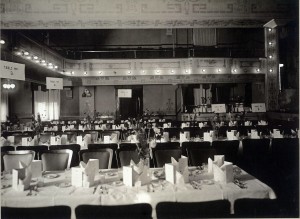
Good old days at the Sheridan Opera House, from Segerberg family archive
Since then, the Sheridan Opera House has seen booms and busts, but ridden the tides of time to landmark architectural prominence, thanks in part to the Sheridan Arts Foundation.
Founded by Keith and Sandra Carradine in 1991, the Sheridan Arts Foundation (SAF), is the 501(c)3 organization that owns and operates the Sheridan Opera House. The nonprofit is committed to preserving the historic character of the building and will commemorate the historic structure’s milestone by replicating the entryway that once stood at the front of the Opera House. The project is estimated to cost a total of $102,000.
A cheaply constructed wood frame and stucco entry, ticket office and stair enclosure was once put up on the south side of the well-constructed brick Opera House. The remnants of the old entryway were removed in 1985 when its owners redesigned the stairs, ticket office, and entry.
The current entryway makes it difficult to do business at the box office in the winter: the doors open and cold air flows in as guests purchase tickets or wait for the house to open. The entry restoration will create an airlock between the outside of the building and the lobby. The result will be a warmer lobby and a utilities cost savings. The entryway restoration is an essential part of the overall restoration. Visitors unfamiliar with Telluride believe the main door to the theatre is merely a side door to the New Sheridan Hotel, since there is no clear distinction between the two buildings.
Once sufficient funds are raised to build the new entryway, the Centennial Celebration Fundraiser shifts its focus to replacing the Sheridan Opera House’s seats, purchased used by the SAF in the 1970s. The seats were refurbished and reupholstered in the 1990s, but they remain large and clunky. New technology has made seats that are more compact, lightweight. and comfortable.
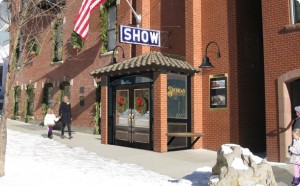
Proposed new entry to historic Sheridan Opera House
There are several ways supporters can donate to the Centennial campaign:
• Sponsor-a-Seat: For a $500 donation (or $1,000 for prime seats) have your name or the name of a loved one on a plaque of your favorite seats for the next 10 years. Just click the “Donate Now” link on the right side of the SAF’s Home Page.
• Donate to the Centennial Celebration Fund: Make a donation of any size online when purchasing tickets online at SheridanOperaHouse.com or drop money in our donation box in the lobby of the Sheridan Opera House.
• Send or drop by with a check made out to the Sheridan Arts Foundation, 110 N. Oak Street (P.O. Box 2680), Telluride, CO 81435
For further information, call 970-728-6363, ext 3
And…
Click the “play” button to listen to my conversation with Ronnie Palamar.


Pingback:Telluride’s Fourth of July: Small Town, Big Happenings | Telluride Inside… and Out
Posted at 16:58h, 30 June[…] the Sheridan Opera House to celebrate the launch of the historic venue’s centennial year. The Speakeasy Gala which includes music, dancing and games of chance begins at 7 p.m. Costumes recommended, though not […]